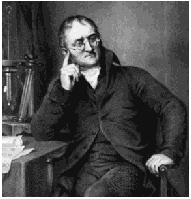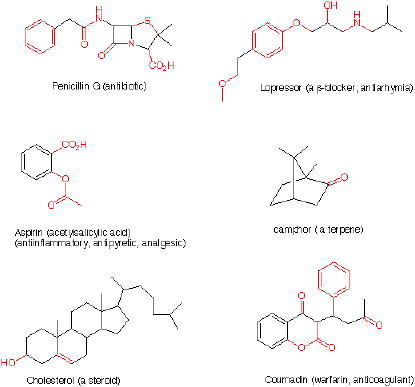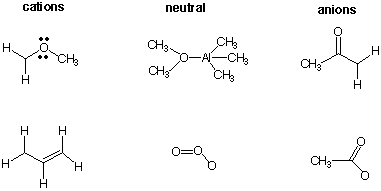Chem 225b - Comprehensive Organic
Chemistry
Problem Set 1
Chapters 1 and 2
Due: Monday, January 23, 2006

John Dalton
(1766-1844)
|
John Dalton's formulation of an
Atomic
Theory in the first decade of the
19th century provided a theoretical basis for understanding
chemical behavior. In addition to defining the Law of
Multiple Proportions, he also formulated the Rule of
Greatest Simplicity, which held that water was a binary
compound, OH. (Note: Dalton did not use our modern symbols,
which came to us from Berzelius,
but rather
circles that were distinguishable
from one another.) Dalton established the combining masses
of H to O in water as ~1:6. This ratio was later refined to
1:8. The Rule
of Greatest Simplicity, which was
at odds with Gay-Lussac's
Law of Combining Volumes of Gases, did not lead to a correct
formulation for the atomic composition of water. Moreover,
although there was agreement regarding the combining masses
of atoms in the first half of the nineteenth century, there
was
disagreement as to the unit mass
of the common atoms encountered in organic chemistry:
hydrogen (1), carbon
(2x6 or 1x12), oxygen (2x8 or
1x16). Since hydrogen was the lightest of the elements, it
was assigned a mass of one, a notion that is unrelated to
today's mass of hydrogen owing to the presence of a single
proton in the hydrogen nucleus. Berzelius's proposal of a
mass scale based upon O = 100 would have worked as well.
For a Brief History of Organic Chemistry
(PowerPoint), click
here.
|
1. Circle and name the functional groups (in
red) in
each of the following compounds. Pages 66 and 351 will be of
help.

2. In the structure of cholesterol (problem #1),
how many primary sp3 carbons (methyl groups) are present?
How many secondary sp3 carbons (methylene groups)? How
many tertiary sp3 carbons (one hydrogen attached)? How
many quaternary sp3 carbons (no hydrogens attached)? How
many sp2 hybridized carbons? What is the molecular formula
of cholesterol? Calculate the percentage of C, H, and O in
cholesterol.
3. For each of the following acids or bases,
identify the corresponding conjugate base or acid, whichever is
appropriate.
a) NaNH2 (sodamide)
b) acetic acid
c) NaOH
d) CH3OH
e) CH3Li
4. Arrange the acids and conjugate acids in
problem #3 in order of decreasing acidity (increasing
pKa).
5. Combustion analysis was, and still is, an
effective method for determining the composition of organic
compounds. Qualitative tests were run to determine the elements
present in the sample. Historically, an organic compound was oxidized
to CO2 (absorbed by KOH) and H2O (absorbed by a
dessicant). The classical studies of Williamson's on the
structure
of ether from 1850-1852 employed this
technique. Williamson prepared unsymmetrical ethers such as
C5H11OC2H5 (n-amyl ethyl
ether; N.B.: amyl is a common name for a 5-carbon chain). Data from
Williamson's paper [Journal
of the Chemical Society, 1852, 4,
229] is shown on the bottom of page
233 in this paper. [Note: Carbonic acid is treated as
CO2.]
a)Using Williamson's calculated values for the
percentage of carbon, hydrogen and oxygen in the ether, determine the
atomic masses of C, H, and O that he employed. Assume H =1.00 )
b) Using the atomic masses from a), the mass of the sample,
CO2, and H2O, calculate the empirical formula
of the ether. Comment.
c) Use the ideal gas law to show that d=PM/RT, where d = vapor
density and M = molecular weight. Use the experimental vapor density
[How many times heavier a given volume of vapor is compared with
air.] of the ether and the density of air (you should know the
composition of air from general chemistry) to show that the molecular
and empirical formulas are the same. All measurements are at the same
temperature and pressure.
6. Place charges in the following structures in
the proper locations. For those structures
that are resonance stabilized, draw the two canonical resonance
structures. For the anions, which one is the
stronger base? Explain
briefly.

7. Given that a regular tetrahedron (methane) may
be inscribed in a cube, use trigonometry to calculate the bond angle
in methane. [Hint: Consider a cube whose center is at the
coordinates x=1, y=1 and z=1.]
